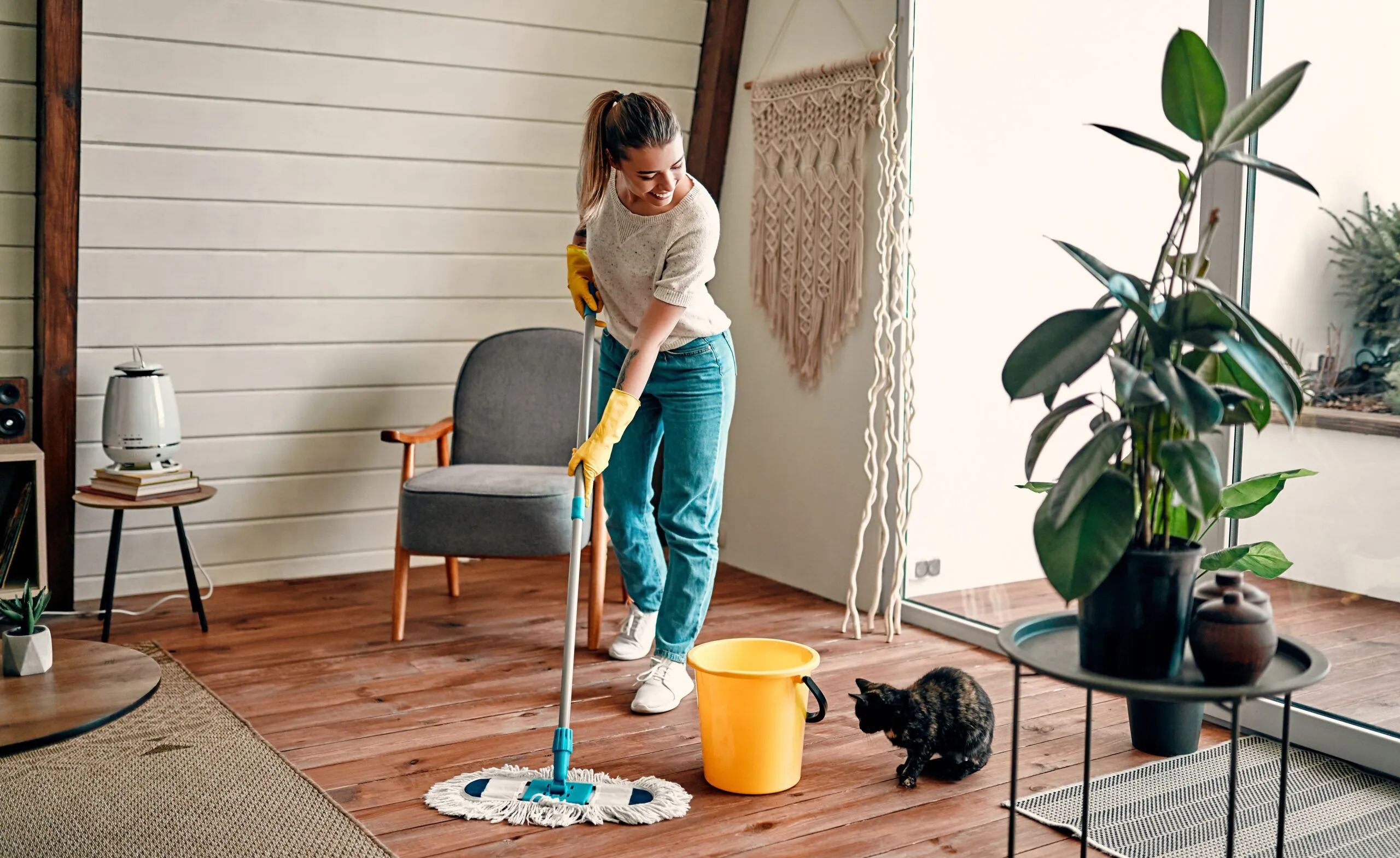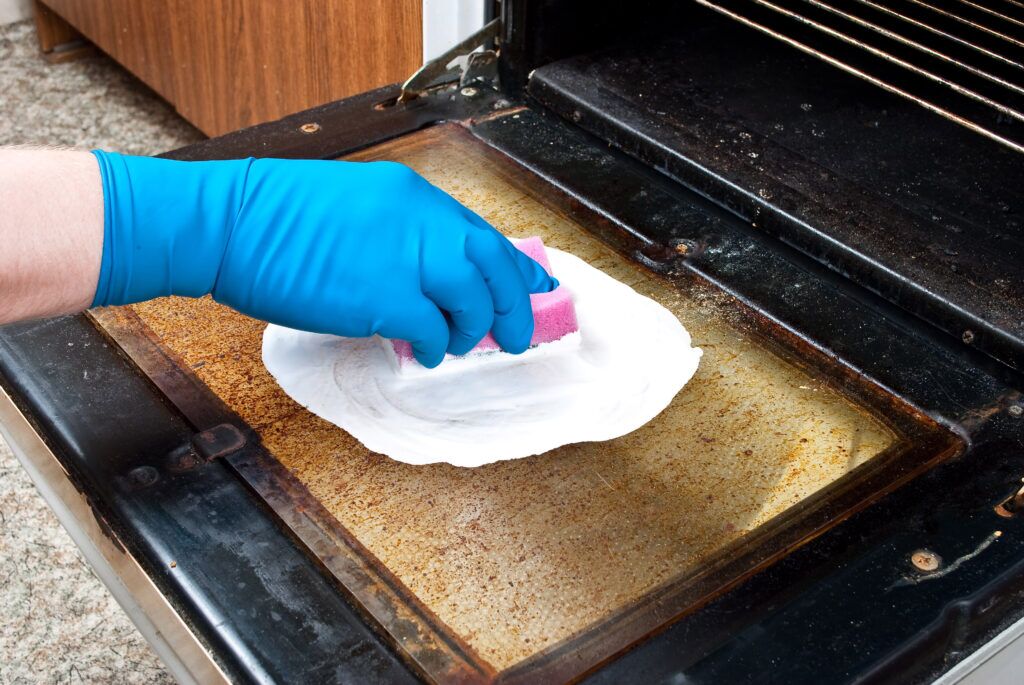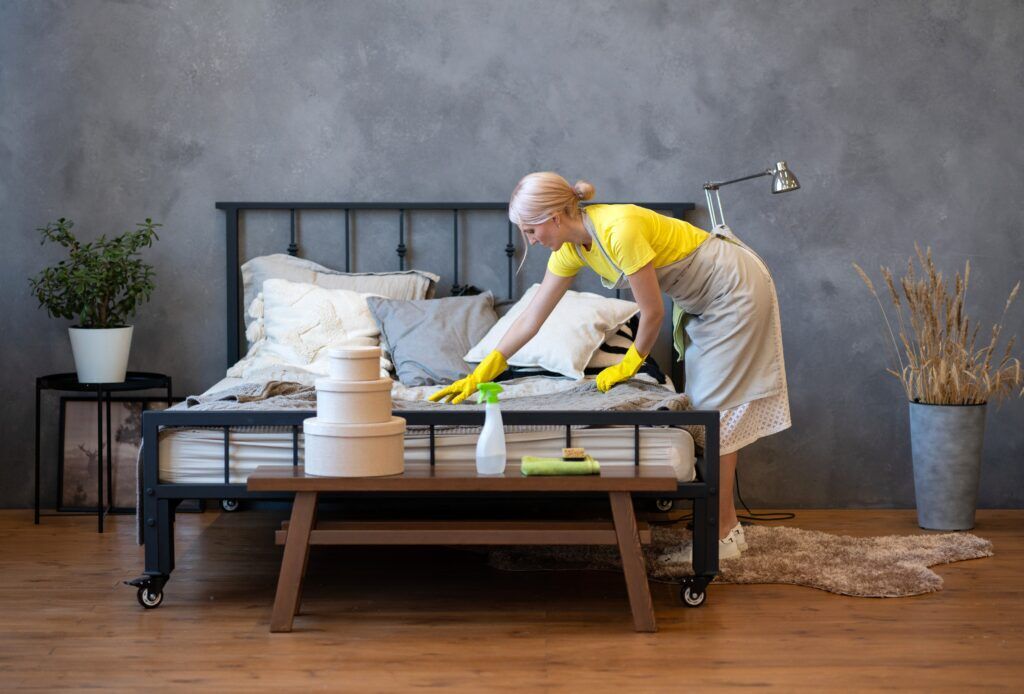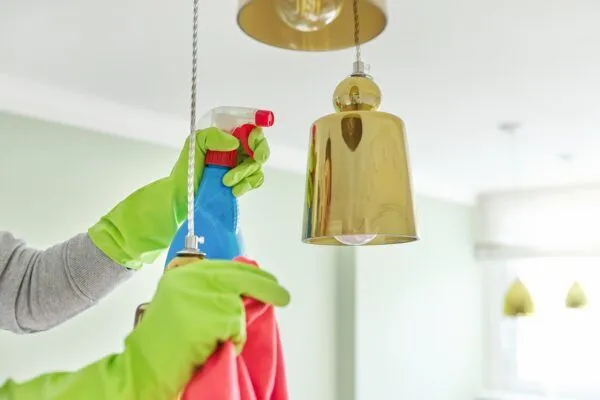
Deep Cleaning Checklist: A Comprehensive Guide to a Spotless Home
Deep cleaning is more than just a routine chore; it’s a meticulous process that delves into the unseen layers of our living spaces, addressing the hidden dirt, grime, and germs that can accumulate unnoticed. While our daily and weekly cleaning routines help maintain a presentable and organised home, they often skim the surface. On the other hand, deep cleaning is about diving deep, reaching those often neglected areas, and ensuring a truly sanitised environment.
It’s about rejuvenating our homes, refreshing our spaces, and promoting a healthier, more vibrant living atmosphere. In this guide, we’ll present a detailed deep cleaning checklist and offer insights into its importance, ensuring that every nook, cranny, and corner of your home receives the thorough care and attention it truly deserves. Alternatively, hire professional house cleaners who will run through this checklist and clean your home for you!
Regular Cleaning vs. Deep Cleaning
Understanding the distinction between regular domestic cleaning and deep cleaning is crucial for maintaining a pristine and healthy living environment. Regular cleaning is the rhythm of daily or weekly chores that ensures our homes are presentable and pleasant. It encompasses dusting surfaces, sweeping floors, and wiping down appliances. These routine activities prevent the accumulation of dirt and keep our spaces fresh.
In contrast, deep cleaning delves into our homes’ hidden corners and crevices, targeting areas that regular cleaning might miss. This involves intensive tasks such as scrubbing baseboards, cleaning grout, and venturing behind appliances. While these chores might be more time-consuming, they are pivotal in ensuring a truly sanitized environment, free from the lurking dirt, grime, and bacteria that can accumulate over time.
To strike a balance between aesthetics and hygiene, it’s essential to integrate both regular and deep cleaning into your home maintenance routine. While regular cleaning maintains a consistent level of cleanliness, periodic deep cleaning ensures the longevity and health of your living space. However, when walls show signs of wear, stains, or fading, a fresh coat of paint can be the perfect finishing touch. Consider hiring a professional interior house painter to refresh and elevate your home’s appearance after deep cleaning.
Your Comprehensive Deep Cleaning Checklist
Ready to get started on your deep cleaning journey? The following checklist breaks down each task room by room, ensuring nothing is overlooked. Let’s dive straight into it.
Kitchen Deep Cleaning

Often considered the home’s heart, the kitchen is one of the busiest areas where families gather, meals are prepared, and memories are made. With constant foot traffic, food preparation, and daily activities, it’s a hub of activity that requires special attention to maintain its cleanliness and functionality. Here are some reasons why deep cleaning your kitchen is important:
- Food Residue: As the primary space for cooking and eating, the kitchen frequently accumulates food spills, splatters, and crumbs. Over time, these can attract pests and lead to mould or bacterial growth if not addressed.
- High-Touch Surfaces: Countertops, appliance handles, and cabinet doors are touched multiple times a day, making them hotspots for germs and bacteria. Regular disinfection is crucial to prevent the spread of illnesses.
- Appliance Maintenance: Appliances like ovens, refrigerators, and microwaves can harbour hidden grime and food particles in their nooks and crannies. Deep cleaning ensures they function efficiently and prolongs their lifespan.
- Drain and Sink Care: Sinks are used daily, leading to potential build-ups from food particles, soap scum, and grease. Without regular deep cleaning, this can result in clogs or unpleasant odours.
- Storage Areas: Pantries and cabinets store both perishable and non-perishable items. Over time, expired products, spilt ingredients, or even unnoticed pests can lurk in these spaces.
- Floor Cleanliness: Given the frequency of spills and dropped food, kitchen floors can become sticky, dirty, and stained faster than other areas in the home. Deep cleaning ensures a safe, slip-free surface.
You achieve more than a hygienic cooking space by giving special attention to these areas through deep cleaning. You also elevate the overall ambience and functionality of the kitchen, transforming it into a welcoming hub for family gatherings and culinary creations. To help you achieve this, here’s a step-by-step guide to deep cleaning your kitchen:
Countertops and Backsplash
- Step 1: Remove items from the countertops, including appliances, utensils, and decor.
- Step 2: Dust off any crumbs or loose debris using a soft brush or cloth.
- Step 3: Spray an all-purpose cleaner onto the surface.
- Step 4: Wipe down with a microfiber cloth in circular motions, ensuring all stains and spills are addressed.
- Step 5: For the backsplash, repeat the process, paying special attention to areas behind the stove or sink where splatters are common.
Refrigerator
- Step 1: Empty the contents, check expiration dates and discard old items.
- Step 2: Remove shelves and drawers.
- Step 3: Clean the interior with water and mild soap. Wipe down walls, base, and roof.
- Step 4: Clean shelves and drawers separately, then return them to the fridge.
- Step 5: Wipe the exterior, paying attention to the handles and the top surface.
Conventional Oven
- Step 1: If your oven has a self-cleaning function, start with that. If not, use an oven cleaner and follow the product’s instructions.
- Step 2: Remove and clean oven racks separately.
- Step 3: Wipe down the interior surfaces.
- Step 4: Clean the oven door, both inside and out.
Microwave Oven
- Step 1: Remove the turntable and any other removable parts.
- Step 2: Clean the interior with water and mild detergent.
- Step 3: Wipe down the exterior, focusing on buttons and handles.
Cabinets and Drawers
- Step 1: Empty out the contents.
- Step 2: Dust the interior to remove any crumbs or debris.
- Step 3: Wipe down the interior surfaces with a damp cloth and mild cleaner.
- Step 4: Clean the exterior, paying special attention to handles and knobs.
- Step 5: Return items, organizing as you go.
Sink and Faucet
- Step 1: Rinse the sink to remove any loose particles.
- Step 2: Apply an all-purpose cleaner or a specialized sink cleaner.
- Step 3: Use a scrub brush to scrub the sink, focusing on the drain and any stains.
- Step 4: Clean the faucet with a cloth, using an old toothbrush to get into crevices and around the base.
- Step 5: Rinse thoroughly and dry with a clean cloth.
Floor
- Step 1: Remove any rugs or mats.
- Step 2: Sweep the floor thoroughly to remove loose dirt and debris.
- Step 3: Fill a bucket with warm water and a floor cleaner suitable for your floor type.
- Step 4: Mop the floor, wringing out the mop well so you don’t oversaturate the floor.
- Step 5: Allow the floor to air dry or dry with a clean cloth. Return rugs or mats once the floor is completely dry.
Special Note: Remember always to read the labels of any cleaning products you use to ensure they’re suitable for the surfaces in your kitchen and to use them safely.
Living Room Deep Cleaning
The living room, often called the home’s communal space, is where families come together to relax, entertain guests, and share moments. Given its central role in daily life, it’s frequently used, making it susceptible to dirt, dust, and wear. Here’s why deep cleaning your living room is essential:
- Dust Accumulation: With electronics, shelves, and various decor items, the living room can quickly become a dust magnet. Over time, this can aggravate allergies and impact indoor air quality.
- Upholstery and Fabric Care: Sofas, curtains, and carpets can trap dirt, allergens, and occasional spills. Regular deep cleaning ensures they remain fresh and prolong their life.
- High-Traffic Area: Being a primary gathering spot, the living room floor experiences significant foot traffic, leading to faster wear and potential staining.
- Electronics: Devices like TVs, gaming consoles, and sound systems can attract dust and need careful cleaning to maintain their performance.
- Windows and Lighting: Clean windows and light fixtures can dramatically brighten a room, enhancing its ambience.
- Decor and Storage: Bookshelves, cabinets, and decor items can harbour dust and need periodic attention to keep the room looking its best.
By meticulously deep cleaning these areas, you ensure a healthier living environment and rejuvenate the space, making it more inviting and comfortable. Here’s a step-by-step guide to deep cleaning your living room:
Furniture and Upholstery
- Step 1: Remove cushions and any removable fabric for separate cleaning or vacuuming.
- Step 2: Vacuum sofas and chairs using appropriate attachments.
- Step 3: Treat any stains with a suitable fabric cleaner.
- Step 4: Dust and wipe down any non-fabric parts of the furniture.
Electronics
- Step 1: Turn off and unplug devices.
- Step 2: Dust the surface using a microfiber cloth.
- Step 3: For screens, use a screen cleaner or a damp cloth, wiping gently.
- Step 4: Clean remote controls, buttons, and knobs.
Windows and Lighting
- Step 1: Dust window sills, frames, and blinds.
- Step 2: Clean the glass with a window cleaner using a squeegee or cloth.
- Step 3: Dust and wipe down light fixtures and lamps.
Floor
- Step 1: Remove any rugs or mats.
- Step 2: Vacuum the floor, ensuring you reach under furniture.
- Step 3: Consider deep cleaning with a carpet cleaner if you have a carpet.
- Step 4: For hard floors, mop using a suitable cleaner.
- Step 5: Allow the floor to dry. Replace rugs or mats afterwards.
Decor and Storage
- Step 1: Remove items from shelves or cabinets.
- Step 2: Dust and wipe down surfaces.
- Step 3: Clean and return items, reorganising as needed.
Bedroom Deep Cleaning

The bedroom is your sanctuary, a place where you recharge and unwind. Given the significant hours spent here, maintaining its cleanliness is essential for your well-being and a restful sleep. Here’s a detailed guide to deep cleaning your bedroom:
Bedding and Mattresses
- Step 1: Strip the bed of all linens, including sheets, pillowcases, and comforters.
- Step 2: Wash the bedding in warm water with a gentle detergent.
- Step 3: Vacuum the mattress thoroughly, especially the seams and edges, to remove dust mites and allergens.
Wardrobes and Closets
- Step 1: Empty the contents and sort through items, discarding or donating what you no longer need.
- Step 2: Dust shelves and hanging rods.
- Step 3: Wipe down the interior and exterior surfaces with a damp cloth.
Under the Bed:
- Step 1: Remove any stored items and declutter.
- Step 2: Vacuum thoroughly, ensuring you reach all corners.
Personal Items and Decor:
- Step 1: Carefully remove items from dressers, nightstands, and shelves.
- Step 2: Dust each item individually.
- Step 3: Wipe down surfaces with a microfiber cloth, ensuring they’re free of dust and grime.
Floor and Carpets:
- Step 1: Start by vacuuming carpets or rugs, paying attention to edges and under furniture.
- Step 2: First, sweep hardwood or tiled floors to remove loose debris, then mop using a suitable cleaner.
- Step 3: Allow floors to dry thoroughly before placing any items back.
Following this guide’ll ensure a fresh, clean, and serene environment for a restful night’s sleep.
Bathroom Deep Cleaning
The bathroom, a daily hub of personal hygiene and care, is frequently exposed to moisture, making it a prime area for mould, mildew, and bacteria. Given its importance and constant use, a thorough deep cleaning is essential to maintain its cleanliness and safety. Here’s a detailed guide to deep cleaning your bathroom:
Shower and Bathtub
- Step 1: Remove bottles, soaps, and accessories from the shower or bathtub.
- Step 2: Apply a bathroom-specific cleaner, letting it sit for a few minutes to break down soap scum and mineral deposits.
- Step 3: Use a scrub brush or a scrubbing pad to clean the surfaces, paying special attention to corners, grout lines, and any stained areas.
- Step 4: Rinse thoroughly with water.
Toilet (Inside and Out)
- Step 1: Pour toilet cleaner into the bowl, ensuring it covers all areas, especially under the rim.
- Step 2: While the cleaner sits, wipe the exterior of the toilet with disinfectant wipes or a cloth with an all-purpose cleaner.
- Step 3: Scrub the bowl with a toilet brush, reaching all corners.
- Step 4: Flush to rinse.
Sink and Countertop
- Step 1: Clear the countertop of items like toothbrushes, soaps, and cosmetics.
- Step 2: Apply an all-purpose cleaner to the sink and countertop.
- Step 3: Wipe down with a cloth or sponge, ensuring you clean the faucet and handles as well.
Mirrors and Fixtures
- Step 1: Spray mirrors with a glass cleaner.
- Step 2: Wipe down using a microfiber cloth in a circular motion for a streak-free finish.
- Step 3: Clean other fixtures like towel racks and light fixtures with a damp cloth.
Floor and Tiles
- Step 1: Sweep the floor to remove loose debris.
- Step 2: Mop the floor using a bathroom-friendly cleaner. If using a steam mop, ensure it’s safe for your floor type.
- Step 3: Use a scrub brush or cloth with the cleaner to remove any soap scum or buildup from wall tiles, especially in the shower area. Rinse afterwards.
Adhering to this guide will ensure a sanitised, sparkling, and fresh-smelling bathroom, enhancing your daily routines.
Additional Areas
In addition to the primary spaces in your home, it’s essential to give attention to these often-overlooked areas during your deep cleaning sessions:
Hallways
Hallways are the arteries of your home, connecting various rooms and guiding the flow of daily life. Due to their transitional nature, they often accumulate dust, dirt, and scuff marks from constant foot traffic. It’s essential to deep clean hallways to ensure a consistent, clean feel throughout your home. Consider wiping down baseboards, cleaning light fixtures, and addressing any wall marks or scuffs for a refreshed appearance.
Staircases
Staircases are more than just functional structures; they’re high-traffic zones that can trap dirt, especially if they’re carpeted. The nooks and crannies of each step, combined with handrails that are touched multiple times a day, make staircases a hotspot for dust and germs. Regular vacuuming, carpet spot treatment, and wood polishing can rejuvenate your staircase, making it clean and safe.
Laundry Room
Ironically, the laundry room, a hub of cleanliness, can become one of the messiest places. Lint accumulations, detergent spills, stray socks, and cluttered products can quickly make this space chaotic. A deep clean involves checking dryer vents, wiping down machines inside and out, organising products, and ensuring the floor is free from detergent or fabric softener residues. A clean laundry room ensures your clothes are washed in a pristine environment and can extend your washing appliances’ life.
Home Office
In today’s digital age, the home office has become a central workspace for many. However, dust can settle amidst the papers, cables, and electronic devices, and clutter can accumulate. Regular cleaning is vital not only for hygiene but for productivity. Wipe down surfaces, organise cables, clean computer screens and keyboards, and declutter papers. A tidy workspace can enhance focus, reduce stress, and prolong the life of your electronic devices.
Garage
Often seen as a secondary storage space, the garage houses cars, tools, equipment, and often, items we need help finding where to place. Over time, it can become a haven for clutter, dust, and pests. Deep cleaning involves organising tools, checking for any oil spills or leaks, sweeping the floor, and ensuring stored items are in good condition. A well-maintained garage can not only make daily tasks like parking more accessible but can also extend the lifespan of stored items and reduce the risk of pests.
Outdoor Deep Cleaning: Retaining Walls & Concrete Sleepers
Deep cleaning isn’t just for indoor spaces—outdoor structures, like retaining walls and concrete sleepers, also need attention to maintain their durability and appearance. Over time, dirt, moss, and weather-related wear can weaken these structures, making regular maintenance essential.
For homeowners in Adelaide, keeping retaining walls clean ensures long-term stability while preserving their visual appeal. Whether you’re dealing with concrete sleepers or other retaining materials, using the right cleaning techniques can prevent damage and extend their lifespan.
For expert supplies and maintenance solutions, visit Retaining Wall Supplies Adelaide and explore Concrete Sleepers Adelaide for durable, high-quality options.
Dedicating time to these areas during your deep cleaning routine ensures that every part of your home reflects care, attention, and thorough cleanliness.
Essential Tools and Supplies for Deep Cleaning

Embarking on a deep cleaning journey requires more than effort; it demands the right tools and supplies to ensure every corner shines and every surface is sanitised. Here’s a curated list of must-haves to make your deep cleaning effective and efficient:
Microfiber Cloths
These versatile cloths are a cleaning staple. Their unique fibres trap dust, dirt, and grime without scratching surfaces, making them ideal for various surfaces, from glass to wood.
Scrub Brushes
Different sizes and stiffness levels can address a range of tasks. From stubborn bathroom grime to kitchen spills, a good scrub brush can make challenging tasks more manageable.
All-Purpose Cleaner
A high-quality all-purpose cleaner is the backbone of your cleaning arsenal. It’s versatile enough to tackle most surfaces in your home, breaking down dirt and leaving areas spotless.
Glass Cleaner
A dedicated glass cleaner is essential for streak-free windows, mirrors, and other glass surfaces. It not only ensures clarity but also prevents residue build-up.
Toilet Cleaner
Given the nature of toilets, a specialized cleaner is crucial. It should clean and disinfect, ensuring a hygienic bathroom environment.
Steam Mop or Traditional Mop
Choose between a steam mop (which sanitises using heat) or a traditional mop depending on your preference and floor type. Both are effective in ensuring clean, safe floors throughout your home.
Armed with these tools and supplies, you’re well-equipped to give your home the deep cleaning it deserves, ensuring both cleanliness and peace of mind.
More Tips for Effective Deep Cleaning

To make the most out of your deep cleaning session, follow these tips:
- Setting a schedule: Plan your deep cleaning session and stick to a schedule.
- Prioritising areas: Focus on the areas that need the most attention, such as high-traffic areas or areas that were last cleaned a while ago.
- Safety precautions: Wear gloves and protective gear when necessary and keep cleaning solutions out of reach of children and pets.
- Eco-friendly cleaning options: Use eco-friendly cleaning solutions and products to reduce your carbon footprint and protect the environment.
Conclusion
Deep cleaning is not just a task; it’s an investment in your home’s health, comfort, and aesthetics. By delving into the nooks and crannies, addressing the unseen layers of dirt and grime, and rejuvenating every space, you’re ensuring a pristine living environment and fostering a sense of well-being and tranquillity. This comprehensive guide serves as a roadmap to navigate the intricacies of deep cleaning, ensuring that every corner of your home radiates cleanliness and care.
However, while many homeowners opt for a DIY approach, there’s undeniable value in considering professional cleaners. These experts have specialised tools, expertise, and experience to tackle even the most challenging cleaning tasks, often delivering results beyond our expectations. Hiring the service of cleaning professionals can save time, reduce the hassle, and guarantee a thorough, deep clean that might be difficult to achieve independently.
Read about house cleaning prices here.
Remember, a clean home is more than just a visual delight; it’s a foundation for a healthier, happier life. Whether you choose to tackle the task yourself or enlist the help of experts, the goal remains the same: a spotless, refreshing living space that brings joy and peace to its inhabitants.
